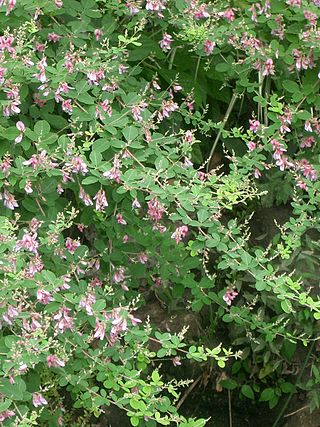
Dactylorhiza fuchsii, the common spotted orchid, is a species of flowering plant in the orchid family Orchidaceae.

Gymnadenia is a genus of flowering plants in the orchid family (Orchidaceae) containing 22 terrestrial species. The former genus Nigritella is now included in Gymnadenia.

August Heinrich Rudolf Grisebach was a German botanist and phytogeographer.

Leptotes, abbreviated Lpt in horticultural trade, is a genus of orchids formed by nine small species that grow in the dry jungles of south and southeast Brazil, and also in Paraguay or Argentina. They are small epiphytic plants of caespitose growth that sometimes resemble little Brassavola, as they share the same type of thin terete leaves, though they are more closely related to Loefgrenianthus.

Génépi or génépy is a traditional French herbal liqueur or apéritif popularized in the Alpine regions. Genepi also refers to alpine plants of the genus Artemisia that is used to make a liqueur in the French region of Savoy, where the Artemisia génépi plants grow and where the beverage is commonly produced.

Banksia ornata, commonly known as desert banksia, is a species of shrub that is endemic to south-eastern continental Australia. The Ngarrindjeri people of the Lower Murray region in South Australia know it as yelakut. It has thin bark, serrated, narrow egg-shaped leaves with the lower end towards the base, cream-coloured flowers in a cylindrical spike, and later, up to fifty follicles in each spike, surrounded by the remains of the flowers.

The bicolored roundleaf bat is a species of bat in the family Hipposideridae found in Indonesia, Malaysia, Singapore, the Philippines, Thailand, and Timor-Leste. This bat inhabits caves, rock crevices and tunnels among lowland forests. They roost in large numbers and consume mostly small winged insects. Their navigation and hunting skills come from the use of echolocation. Its leafnose is used to release ultrasonic shouts to distinguish its surroundings. Echolocation is also used to distinguish other species based on their wingbeat and size. The habitat of this bat decides the color of its fur. Bleaching fumes of a cave environment will cause an orange colored fur. Those who inhabit a well-ventilated roost will be a light brown color.

Eucalyptus miniata, commonly known as the Darwin woollybutt or woolewoorrng, is a species of medium-sized to tall tree that is endemic to northern Australia. It has rough, fibrous, brownish bark on the trunk, smooth greyish bark above. Adult leaves are lance-shaped, the flower buds are ribbed and arranged in groups of seven, the flowers orange or scarlet and the fruit is cylindrical to barrel-shaped or urn-shaped, with ribs along the sides.

Gymnadenia corneliana is a species of orchid with light-pink petals, found only in the Southwestern Alps in a small region near the France-Italy border. It was first catalogued by Swiss botanist Gustave Beauverd. Some specimens of this orchid display slightly darker petals, although this is uncommon. This flower, like many orchids in its genus, is said to emit a pleasant odor resembling that of vanilla.

Lespedeza bicolor is a species of flowering plant in the legume family known by the common names shrubby bushclover, shrub lespedeza, and bicolor lespedeza. It is native to eastern Asia, ranging from southeastern Siberia to eastern China, Mongolia, Korea, and Japan. and it is widely grown as an ornamental plant. In some regions, such as the southeastern United States, it grows in the wild as an introduced and invasive species.

Gymnadenia × chanousiana, common name Chanous' gymnadenia, is a natural hybrid between Gymnadenia conopsea and Nigritella rhellicani.

Gymnadenia rhellicani is a European species of orchid.

Erysimum collinum is a plant species in the family Brassicaceae. It is a member of the genus Erysimum, which includes between 150 and 350 species in the Northern Hemisphere.

Nigritella archiducis-joannis is a species of orchid endemic to a few locations in Totes Gebirge, the Dachstein, the Karawanken, the Koralpe – that is the Austrian states Styria, Upper Austria, Salzburg und Carinthia – as well as Triglav National Park.

Gymandenia stiriaca, the Salzkammergut vanilla orchid, is a species of orchid endemic to Austria.

Gymandenia lithopolitanica, the Austrian gymnadenia, is a species of orchid endemic to a portion of the eastern Alps spanning Austria and Slovenia.

Gymandenia bicolor is a species of orchid occurring in the Eastern Alps, the Dinaric Alps and the Carpathian Mountains. It is very similar to Gymnadenia miniata and often seen as a variation and not a separate species.

Gymandenia miniata is a species of orchid native to the Eastern Alps and Carpathian Mountains. It is similar in appearance to Gymnadenia bicolor; both species were split from a former less defined taxon Nigritella rubra which referred to all red flowering Gymnadenia.

Gymnadenia dolomitensis is a species of orchid found in the Dolomites mountain range of Italy.
Gymnadenia minor is a species of orchid endemic to Austria.



















